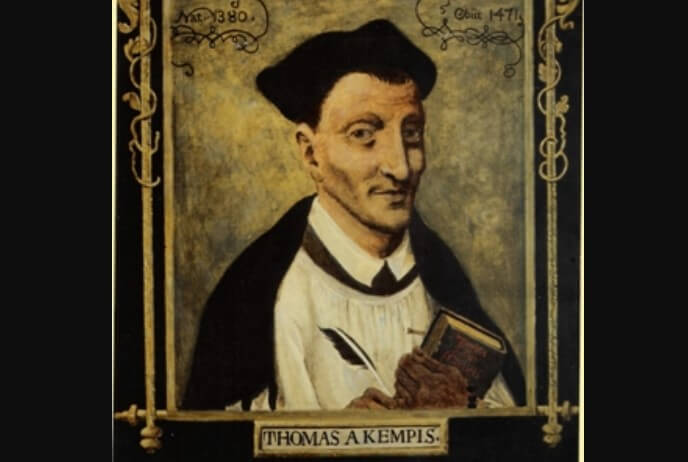Explore the life and works of Thomas à Kempis, a prominent theologian of the late medieval “Devotio Moderna” movement. Learn about his early years, contributions, and the legendary story surrounding his canonization. Delve into his renowned masterpiece, “The Imitation of Christ,” and discover other significant works and biographies penned by this influential figure of the 15th century.

Thomas à Kempis; (c. 1380-1471), German theologian of the Low Countries who was the reputed author of the Imitation of Christ. He is generally considered the most outstanding representative of the late medieval religious movement known as the “Devotio Moderna.”
Biography
Thomas was born in Kempen in the Rhineland. His original surname was Hemerken, meaning “little hammer” in reference to his family’s profession, which was later Latinized into “Malleolus.” His father, Johann, worked as a blacksmith, while his mother, Gertrud, was a schoolmistress. Despite being commonly known in English as Thomas à Kempis, the “a” in his name represents the Latin word “from” and is incorrectly accented. In his writings, he referred to himself as “Thomas Kempensis” or “Thomas Kempis.”
In 1392, Thomas joined his brother Johann in Deventer, Netherlands, to attend a renowned Latin school. During his time there, he came across the Brethren of the Common Life, followers of Gerard Groote’s Modern Devotion. Thomas studied in Deventer from 1392 to 1399.
After completing his studies, Thomas visited his brother Johann in Zwolle, where Johann had become the prior of the Monastery of Mount St. Agnes. This monastery, belonging to the Canons Regular of the Congregation of Windesheim, was founded by followers of Groote to adhere more closely to the monastic norms of the time. Thomas officially joined Mount St. Agnes in 1406, and although he wasn’t ordained a priest until nearly ten years later, he became a prolific copyist and writer.
Thomas received Holy Orders in 1413 and was appointed sub-prior of the monastery in 1429. His first term as subprior was interrupted by the community’s exile from Agnetenberg in 1429 due to a dispute over the appointment of the Bishop of Utrecht. The exile lasted until 1432 when the disagreement was resolved. During this period, Thomas cared for his ailing brother in Arnhem until his brother’s death in November 1432.
Thomas spent his time engaged in devotional exercises, writing, and copying manuscripts, including four copies of the Bible. He was well-versed in the teachings of the Bible, and his works frequently incorporated biblical quotations, especially from the New Testament.
As subprior, Thomas was responsible for instructing novices. During this time, he wrote four booklets between 1418 and 1427, later compiled and titled “The Imitation of Christ,” named after the first chapter of the initial booklet. Thomas More regarded it as one of the three books everyone should own. The Imitatio Christi saw thirteen translations and three English paraphrases published between 1500 and 1700.
Thomas passed away near Zwolle in 1471. There is a legend suggesting that the Catholic Church denied his canonization around 200 years after his death due to scratch marks found on the interior of his coffin lid. This legend implies that he may have been buried alive, disqualifying him from sainthood. However, there is limited evidence supporting this claim, and it’s uncertain whether the Church would have denied him sainthood under such circumstances.
Works
Kempis’s original manuscript of “The Imitation of Christ,” dating back to 1441, is preserved in the Royal Library in Brussels (shelfmark: MS 5455-61).
In addition to “The Imitation of Christ,” he authored biographies of key figures in the New Devotion movement, including Gerard Groote, Floris Radewijns, Jan van de Gronde, and Jan Brinckerinck.
Among his notable works are a series of sermons delivered to the novices of St. Augustine Monastery. These sermons include “Prayers and Meditations on the Life of Christ,” “Meditations on the Incarnation of Christ,” “Of True Compunction of Heart,” “Soliloquy of the Soul,” “Garden of Roses,” “Valley of Lilies,” and a biography of St. Lidwina of Schiedam.